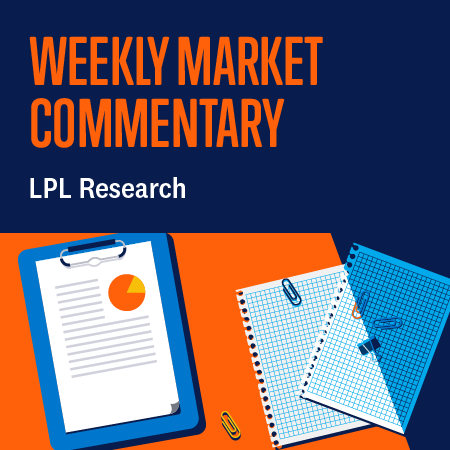With the first presidential debate behind us, it’s safe to say election season is in full swing. While last week’s debate was light on economic policies, the future of tax policy (along with potential efforts to arrest elevated federal deficits) could have broad implications for the municipal (muni) market — some good, some not so good. With the Tax Cuts and Jobs Act (TCJA) set to sunset in 2025, the election will go a long way in determining the future of tax policy in the U.S. And for muni securities and their unique tax-exemption characteristics, the election will go a long way in determining future demand for the asset class. But with the Federal Reserve (Fed) embarking on a rate cutting cycle likely starting this week, the next few months could be the last “best time” to buy munis, regardless of changes to tax policy.
Second quarter earnings season is in the books, and it was a good one. S&P 500 companies collectively grew earnings at a double-digit pace for the first time in three years. Companies beat estimates at a solid 79% clip. Guidance from company CEOs and CFOs was relatively upbeat. And although some were a bit disappointed by big technology results based on stock reactions, the problem was high expectations more than anything else.
In December 2023, Vladimir Putin declared that the 2024 BRICS Summit, hosted by Russia, would be focused on establishing a “fair world order” based on shared principles. At the core of Putin’s goals for stronger BRICS economic integration is a longstanding and overriding objective to provide a viable alternative to the West’s global hegemony in nearly all facets of political, military, economic, financial, and security affairs.
In his recent speech, Federal Reserve (Fed) Chairman Jerome Powell focused on the fragilities of the labor market and is preparing markets for the new phase for policy. “The time has come for policy to adjust.” A soft landing looks achievable, barring any shocks. Disinflation while preserving labor market strength is only possible with anchored inflation expectations, so an independent and credible central bank is key. One of the best concepts in the speech for investors to understand is the current data shows an evolving macro landscape. The jury is still out on if the Fed can successfully manage the risks to both sides of their dual mandate.
Every year as the summer months draw near their end, LPL Financial hosts its annual Focus conference for financial advisors. While the conference is an excellent opportunity for advisors to expand upon professional interests, discover ways to enhance their impact on clients, and connect with industry experts — learning is a two-way street. At this year's big event with nearly 9,000 attendees in sunny San Diego, the LPL Research team had the unique opportunity to connect with many of these advisors in person to get their perspectives on the capital markets. Below are some of the frequently asked questions from the road.
Pullbacks are the stubbed toe of the stock market. I was reminded of this over the last week as I contemplated the recent surge in volatility while picking up toys after our two-year-old finally fell asleep. As I carried a Tonka truck back to its usual parking spot next to the toy farm, I slammed my toe into the foot of the couch. The pain was acute, but not worthy of a full-blown panic. After a few deep breaths, the sting began to wear off and I assessed the damage to find a little redness, but nothing broken. Somewhere in this painful process, the parallels between my toe’s unfortunate encounter with the couch and the recent equity market sell-off became clear. For the market over the last week, the foot of the couch was embodied by overbought conditions — especially in big tech, waning confidence for a soft landing due to weak employment data and a contractionary Institute of Supply Management (ISM) manufacturing reading, and the rapid unwinding of the crowded yen carry trade.
Before the jobs report was released on Friday, we wrote a commentary on the U.S. dollar. In light of the events over the weekend and Monday, we start with some comments on the global stock market selloff.
The broad stock market benchmarks are down about 3% this morning as several factors have lined up to create conditions for a sharp global selloff. A batch of weak economic data, notably Friday’s jobs report, sparked concerns that the Federal Reserve (Fed) may have taken its higher-for-longer rate policy too far.
After such a strong rally since last fall, valuations, sentiment, and investor positioning had become stretched. What markets are experiencing today is an unwinding of that bullish positioning, which is particularly evident in the yen and the so-called carry trade. Japan’s Nikkei suffered its worst one-day decline since 1987.
Where do we go from here? We anticipated more volatility, as we discussed in the LPL Research Midyear Outlook 2024, based on the size of this year’s move, evidence of stretched positioning and elevated valuations. A capitulating Fed, timely evidence of a growing economy, and a test of the 200-day moving average on the S&P 500 are some factors to consider as we wait for the market’s bottoming process to play out.
For more of our thoughts on this global bout of volatility, please follow the LPL Research blog.
Investors had a healthy appetite for risk so far this year as a so-called potential soft landing has been factored in. We have an economy with rising wages, decelerating inflation, and a Federal Reserve (Fed) on the cusp of cutting rates. What more could you ask for? Of course, political uncertainty and headwinds from geopolitical risks could rain on that parade, and that’s why investors should exhibit discernment in a market like this.
The first half of the year was a challenging environment for a lot of fixed income markets, especially higher-quality markets. With the Federal Reserve (Fed) seemingly unlikely to lower interest rates until after the summer months (at the earliest), the “higher for longer” narrative has kept a lid on any sort of bond market rally. While falling interest rates help provide price appreciation in this higher-for-longer environment, fixed income investors are likely better served by focusing on income opportunities, which has been the traditional goal of fixed income investors. Investors can best navigate the late-cycle economic environment by adding high-quality bonds, offering attractive risk-adjusted returns, and lowering overall portfolio volatility. Consider moving away from cash, with the Fed likely to cut rates in the second half.
Outlook 2024: A Turning Point, released in December 2023, featured our perspective on how stocks might respond to turning points in inflation and monetary policy. That response was quite positive, as we now know, as easing inflation, anticipation of Federal Reserve (Fed) rate cuts, increasing chances of a soft landing for the U.S. economy, and artificial intelligence (AI) excitement combined to send stocks up double-digits over the first six months of 2024. Now past the halfway mark, a lot of good news is priced in, valuations are elevated, and monetary policy may not offer much opportunity for upside. If stocks are going to add to first-half gains in the second half, earnings must play a key role.
With stock valuations elevated after such a strong first half, earnings growth will be key to holding, or potentially building on these gains. LPL Research believes stocks have gotten a bit over their skis, but earnings season may not be the catalyst for a pullback in the near term given all signs point to another solid earnings season and stocks have mostly performed well during the peak weeks of reporting season in recent years. We may not get an increase in second-half estimates over the next couple of months — that's a lot to ask — but we should get a few points of upside and double-digit earnings growth for the second quarter on the back of technology strength.
With a Federal Reserve (Fed) meeting, a Bank of Japan (BOJ) meeting, two very important inflation reports, and nearly $120 billion of new Treasury securities auctioned — last week was quite the week for markets. And while the Fed meeting was supposed to get top billing, it turned out the inflation data stole the show. In fact, at least for the Treasury market, it’s been the economic data that has had the largest impact on changing bond prices/yields. But with economic data released daily, that has meant the volatility in the Treasury market has been dizzying lately. So, what should bond investors do during this period of heightened volatility? Keep calm and clip bond coupons.


